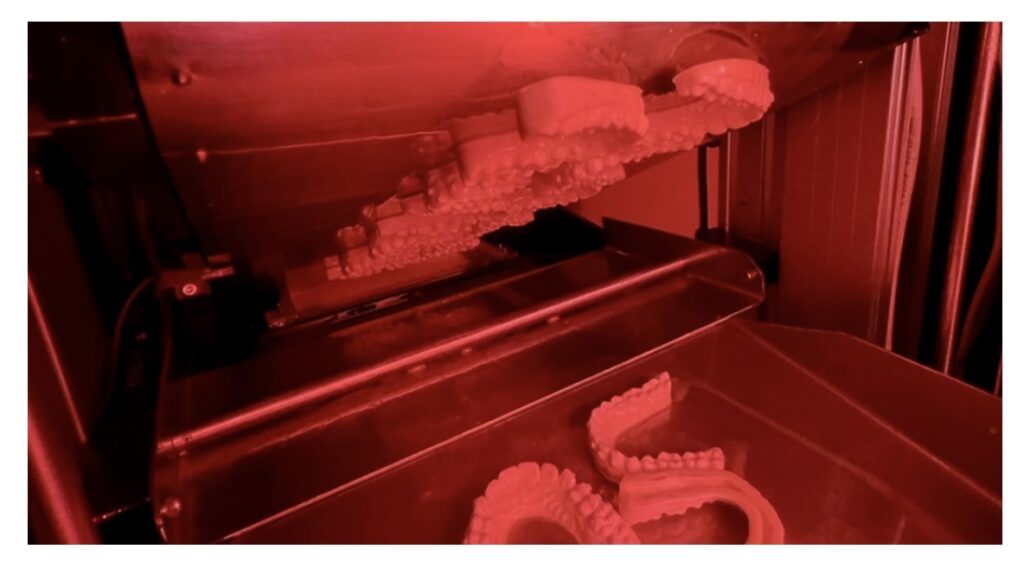Sprybuild is based in Israel but staffed by engineers who came from Ukraine due to the war. The company aims to increase the yield of vat polymerization 3D printers by offering a system with a conveyor belt and a continuous build process. Previously, Nano Dimension’s Admatec had a conveyor belt system, while 3D Systems and others have sought to create continuous build processes and automation for years. Now, this small startup may crack the vat polymerization market with their approach.
The company wants to make a relatively compact system that has a metal conveyor belt moving above a DLP projection head. The key innovation they have is a magnetic surface stabilization system that coupled with that conveyor belt gives them high yields. The conveyor moves at a 45 degree angle over the optic. After printing parts are automatically removed from the platform allowing the system to keep on 3D printing. A dedicated post-processing unit will partially automate those workflows also. Sprybuild’s continuous build process also solves the issues of continually having to clear the optical window and to keep the resin you don’t want to harden from hardening. The company claims build speeds of 55 mm/min at 100 micron layers and says it’s 20 times faster than most other vat based systems.
Sprybuild also has its own nesting and slicing software to speed up setup times. The system is designed to be open, accommodating a variety of third-party resins. The firm aims to create custom versions of its printer for different applications and industries, with dedicated systems for eyewear, orthopedics, insoles, jewelry, and more in the pipeline.
It’s encouraging to see innovation in vat polymerization. If Sprybuild can maintain a good interface that avoids constant wiping and keeps the optics functioning well, it could provide a high-speed solution that rivals or surpasses Carbon’s. Should the machine be reasonably priced, the firm could become an attractive option compared to Carbon’s expensive lease pricing. While it may be challenging to replace the widely used Perfactories, the smaller form factor of Sprybuild’s system could encourage consideration of alternative solutions, especially as firms are now more attuned to worker safety and labor costs. Effective automation could significantly impact, particularly for firms in Switzerland, Europe, or similar regions. An open system and approach align with current market demands for material options and access to volume pricing. There’s notable interest in open materials systems and approaches recently, as manufacturing demands evolve and companies seek lower pricing. Additionally, as startups develop niche and high-performance materials, users are eager to access the latest innovations, such as ceramic-filled or copper-doped materials.
Sprybuild’s combination of a continuous pass-off of new parts over an optic that builds and then removes the parts continuously is indeed a logical approach to maximizing printer efficiency. Ideally, this setup would allow for the printer to operate almost ceaselessly, with minimal intervention required until the resin runs out, potentially leading to very low part costs. Compared to other systems, operator involvement is significantly reduced, which can save costs, reduce part failures, improve overall repeatability, and enhance worker safety. In a world where labor is more expensive and workers have more job options, the appeal of a system that minimizes the need for manual removal and cleaning of build platforms is clear. While it remains to be seen if Sprybuild can navigate the market effectively enough to displace established competitors, their innovative approach and ceaseless 3D printing system could serve as a significant catalyst for more automation in the industry and prompt a reevaluation of part print speed, overall time to part, and cost per part.
Subscribe to Our Email Newsletter
Stay up-to-date on all the latest news from the 3D printing industry and receive information and offers from third party vendors.
You May Also Like
IperionX Inks 10-Year Deal with Wisconsin Manufacturer for 80 Metric Tons of Titanium Per Year
IperionX, the Charlotte-based supplier of sustainable titanium powders used for additive manufacturing (AM) and metal injection molding (MIM), has signed a ten-year deal with United Stars, a group of industrial...
America Makes Announces IMPACT 2.0: $6.6M in New 3D Printing Funding
America Makes, the Manufacturing Innovation Institute (MII) based in Youngstown, Ohio, has announced IMPACT (Improvement in Manufacturing Productivity via Additive Capabilities and Techno-Economic Analysis) 2.0, a project call which will...
Latest Earnings Overview for Australian 3D Printing Firms Titomic and AML3D
Australian 3D printing manufacturing firms Titomic (ASX: TTT) and AML3D (ASX: AL3) reported their financial results for the period from July to December 2023, marking the first half of their...
AML3D’s Ohio Expansion: Capital Infusion and Defense Contracts to Boost U.S. 3D Printing Operations
Australia-headquartered AML3D (ASX: AL3) is making headway into the United States market with strategic expansion plans and a fresh capital infusion. The company, specializing in advanced wire arc additive manufacturing...

































